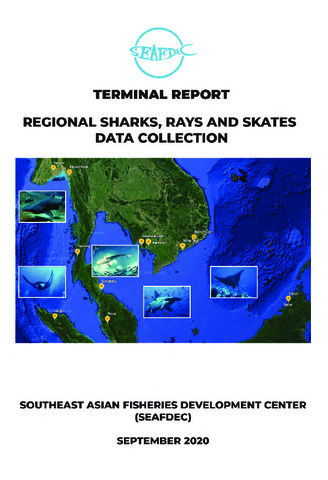Ipakita ang simpleng tala ng item
Terminal Report Regional Sharks, Rays and Skates Data Collection
Share
| dc.contributor.author | Wanchana, Worawit | |
| dc.contributor.author | Ali, Ahmad | |
| dc.contributor.author | Sulit, Virgilia T. | |
| dc.contributor.author | Chanrachkij, Isara | |
| dc.contributor.author | Arnupapboom, Sukchai | |
| dc.contributor.author | Sayan, Suwanee | |
| dc.date.accessioned | 2020-11-03T04:21:50Z | |
| dc.date.available | 2020-11-03T04:21:50Z | |
| dc.date.issued | 2020 | |
| dc.identifier.citation | Worawit, W., Ahmad, A., Sulit, V.T., Isara, C., Sukchai, A. and Suwanee, S. (2020) Terminal Report Regional Sharks, Rays and Skates Data Collection. Southeast Asian Fisheries Development Center (SEAFDEC); 348 pp | en |
| dc.identifier.uri | http://hdl.handle.net/20.500.12066/6581 | |
| dc.description.abstract | A one-year study on sharks data collection had been implemented from year 2015 to 2016 in collaboration with six SEAFDEC Member Countries with technical support from SEAFDEC Marine Fishery Resources Development and Management Department (SEAFDEC/MFRDMD) and SEAFDEC Training Department (SEAFDEC/TD) under financial support mainly from CITES Secretariat and the Japanese Government. The Standard Operation Procedures (SOP) for Sharks, Rays and Skates Data Collection in the Southeast Asian Waters published by SEAFDEC was used as regional standard for collecting and reporting national data. Information on trade and marketing were also included in this study. Another study was conducted in Cambodia and Myanmar in 2018-2019. During 2015-2016 study, from a total of 18,097 tons of fish landed in the participating countries during this study, it was found that catch composition of rays, sharks and skates were only 0.9%, 1.4%, and 0.1%, respectively. It was recorded that the landing range from 0.6-5.15% for rays, 0.2-20.7% for sharks, and 0.002-0.3% for skates. It should be noted that the landing of skates was recorded only in Myanmar and Viet Nam. A range of landing per month in the participating countries was 448-4,254 kg for rays, 364-16,445 kg for sharks, and 7-1,650 kg for skates, respectively. A total of 33,495 individual of rays, sharks and skates comprising of 18,546 rays, 13,504 sharks and 1,445 skates were sampled. Total number of species recorded under this study was 70 species of rays, 53 species of sharks, and 5 species of skates. The most abundant species (by number) were Telatrygon biasa for rays, Chiloscyllium punctatum for sharks, and Okamejei cairae for skates. The highest landing by weight was Mobula japonica (37,573 kg with size range from 32-100cm DL) for rays, Alopias superciliosus (53,504 kg with size range from 65-366cm TL) for shark, and Okamejei cairae (17,501 kg, size range 10-58cm TL) for skate. Regarding fishing effort (CPUE, kg/haul), it was reported that CPUE of trawl fishing range from 0.002-1.46kg, and 0.003-1.023kg for rays and sharks respectively. For gillnet, it was found that CPUE was from 0.008-19.5kg for rays, and 0.005-11.82kg for sharks. Catch per Unit Effort for longline was from 0.04-4.87kg for rays, and 0.5-6.6kg for sharks. For skates, CPUE was range from 0.01- 2.3kg/haul only in trawl fishing. Regarding the price and marketing of sharks, rays and skates, it range from 1-7.34 USD/kg for rays, 0.22-8.99 USD/kg for sharks, and 0.2-2 USD/kg for skates. The price varies pending on species, size and demand. Almost all sharks, rays, and skates was mainly utilized locally and some products were for foreign markets. | en |
| dc.language.iso | en | en |
| dc.publisher | Secretariat, Southeast Asian Fisheries Development Center | en |
| dc.subject | Sharks | en |
| dc.subject | Rays (fish) | en |
| dc.subject | Skates | en |
| dc.subject | data collection | en |
| dc.title | Terminal Report Regional Sharks, Rays and Skates Data Collection | en |
| dc.type | Book | en |

